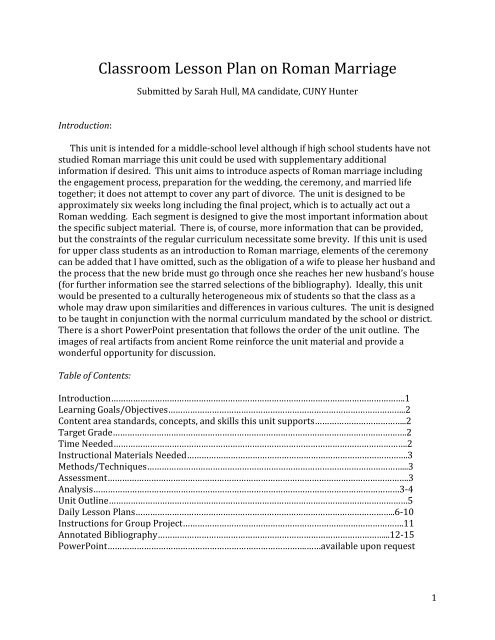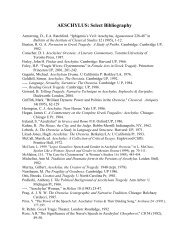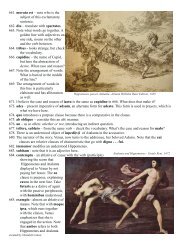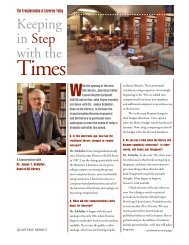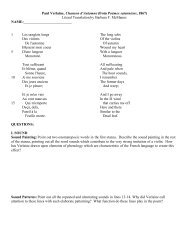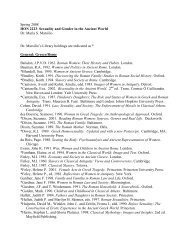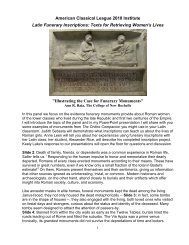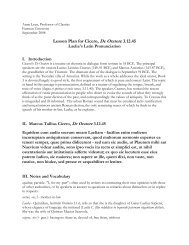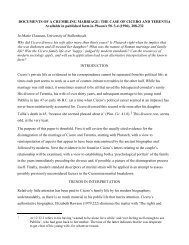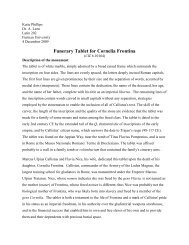Classroom Lesson Plan on Roman Marriage
Classroom Lesson Plan on Roman Marriage
Classroom Lesson Plan on Roman Marriage
You also want an ePaper? Increase the reach of your titles
YUMPU automatically turns print PDFs into web optimized ePapers that Google loves.
<str<strong>on</strong>g>Classroom</str<strong>on</strong>g> <str<strong>on</strong>g>Less<strong>on</strong></str<strong>on</strong>g> <str<strong>on</strong>g>Plan</str<strong>on</strong>g> <strong>on</strong> <strong>Roman</strong> <strong>Marriage</strong><br />
Submitted by Sarah Hull, MA candidate, CUNY Hunter<br />
Introducti<strong>on</strong>:<br />
This unit is intended for a middle‐school level although if high school students have not<br />
studied <strong>Roman</strong> marriage this unit could be used with supplementary additi<strong>on</strong>al<br />
informati<strong>on</strong> if desired. This unit aims to introduce aspects of <strong>Roman</strong> marriage including<br />
the engagement process, preparati<strong>on</strong> for the wedding, the cerem<strong>on</strong>y, and married life<br />
together; it does not attempt to cover any part of divorce. The unit is designed to be<br />
approximately six weeks l<strong>on</strong>g including the final project, which is to actually act out a<br />
<strong>Roman</strong> wedding. Each segment is designed to give the most important informati<strong>on</strong> about<br />
the specific subject material. There is, of course, more informati<strong>on</strong> that can be provided,<br />
but the c<strong>on</strong>straints of the regular curriculum necessitate some brevity. If this unit is used<br />
for upper class students as an introducti<strong>on</strong> to <strong>Roman</strong> marriage, elements of the cerem<strong>on</strong>y<br />
can be added that I have omitted, such as the obligati<strong>on</strong> of a wife to please her husband and<br />
the process that the new bride must go through <strong>on</strong>ce she reaches her new husband’s house<br />
(for further informati<strong>on</strong> see the starred selecti<strong>on</strong>s of the bibliography). Ideally, this unit<br />
would be presented to a culturally heterogeneous mix of students so that the class as a<br />
whole may draw up<strong>on</strong> similarities and differences in various cultures. The unit is designed<br />
to be taught in c<strong>on</strong>juncti<strong>on</strong> with the normal curriculum mandated by the school or district.<br />
There is a short PowerPoint presentati<strong>on</strong> that follows the order of the unit outline. The<br />
images of real artifacts from ancient Rome reinforce the unit material and provide a<br />
w<strong>on</strong>derful opportunity for discussi<strong>on</strong>.<br />
Table of C<strong>on</strong>tents:<br />
Introducti<strong>on</strong>………………………………………………………………………………………………………….1<br />
Learning Goals/Objectives……………………………………………………………………………………..2<br />
C<strong>on</strong>tent area standards, c<strong>on</strong>cepts, and skills this unit supports………………………………..2<br />
Target Grade………………………………………………………………………………………………………….2<br />
Time Needed………………………………………………………………………………………………………….2<br />
Instructi<strong>on</strong>al Materials Needed……………………………………………………………………………….3<br />
Methods/Techniques……………………………………………………………………………………………...3<br />
Assessment…………………………………………………………………………………………………………….3<br />
Analysis………………………………………………………………………………………………………………3‐4<br />
Unit Outline……………………………………………………………………………………………………………5<br />
Daily <str<strong>on</strong>g>Less<strong>on</strong></str<strong>on</strong>g> <str<strong>on</strong>g>Plan</str<strong>on</strong>g>s……………………………………………………………………………………………..6‐10<br />
Instructi<strong>on</strong>s for Group Project……………………………………………………………………………….11<br />
Annotated<br />
Bibliography…………………………………………………………………………………...12‐15<br />
PowerPoint……………………………………………………………………….……available up<strong>on</strong> request<br />
1
Learning Goals/Objectives:<br />
• To introduce students to the world of <strong>Roman</strong> marriage.<br />
• Students will be able differentiate various accepted forms of marriage.<br />
• Students will be able to compare marriage customs of today (in their own respective<br />
cultures) with those of the <strong>Roman</strong>s.<br />
• Students will be able to reenact a <strong>Roman</strong> marriage including unique traditi<strong>on</strong>s of the<br />
<strong>Roman</strong>s.<br />
• Students will better understand the <strong>Roman</strong> world as a whole and the <strong>Roman</strong> family<br />
by understanding how marriage functi<strong>on</strong>s within the society.<br />
• Students will better understand women by understanding societal expectati<strong>on</strong>s of<br />
marriage including ages for marriage and rights and resp<strong>on</strong>sibilities of a married<br />
woman.<br />
C<strong>on</strong>tent area standards, c<strong>on</strong>cepts, and skills this unit supports:<br />
LOTE/Latin for the 21st Century Standard 1 – Students will be able to use a language other<br />
than English for communicati<strong>on</strong>. Checkpoint A, Checkpoint B<br />
LOTE/Latin for the 21st Century Standard 2 – Students will develop cross‐cultural skills<br />
and understandings. Checkpoint A, Partial Checkpoint B<br />
Standards for Classical Language Learning Goal 1 – Communicati<strong>on</strong>/Communicate in a<br />
Classical Language (1.1 and 1.2)<br />
Standards for Classical Language Learning Goal 2 – Culture/Gain Knowledge and<br />
Understanding of Greco‐<strong>Roman</strong> Culture (2.1)<br />
Standards for Classical Language Learning Goal 4 – Comparis<strong>on</strong>s/Develop Insight into Own<br />
Language and Culture (4.1 and 4.2)<br />
Any other standards/skills this unit supports:<br />
Grade 8 ELA Standard 1: Students will read, write, listen, and speak for informati<strong>on</strong> and<br />
understanding.<br />
Grade 8 ELA Standard 2: Students will read, write, listen, and speak for literary resp<strong>on</strong>se<br />
and expressi<strong>on</strong>.<br />
Grade 8 ELA Standard 4: Students will read, write, listen, and speak for social interacti<strong>on</strong>.<br />
Target Grade:<br />
Eighth‐grade students.<br />
Time Needed:<br />
This unit optimally requires six or seven forty‐minute periods. Alternatively it can<br />
be adapted to fit into fifteen to twenty‐minute blocks at the end of class periods instead of<br />
devoting<br />
an entire day to each topic.<br />
2
Instructi<strong>on</strong>al Materials Needed:<br />
− PowerPoint presentati<strong>on</strong> for each segment of the marriage outline to introduce new<br />
cultural material<br />
− Computer and a means of projecting a PowerPoint presentati<strong>on</strong><br />
− Passages of real Latin adapted or glossed regarding marriage to accompany different<br />
segments of the unit<br />
− Classical cookbook creati<strong>on</strong>s, i.e. recipes prepared by the teacher for the class to taste<br />
during the presentati<strong>on</strong><br />
− Paper<br />
− Poster Board<br />
− C<strong>on</strong>structi<strong>on</strong> Paper<br />
− Markers<br />
− Colored Pencils<br />
− Latin Dicti<strong>on</strong>aries<br />
− Instructi<strong>on</strong>s for Project (included in this less<strong>on</strong> plan)<br />
Methods/Techniques:<br />
This module relies heavily <strong>on</strong> comparing and c<strong>on</strong>trasting, with short written<br />
assignments in which the students will participate in a dialogue with the teacher. Students<br />
will also be encouraged to share their observati<strong>on</strong>s with the entire class so that all of the<br />
students can learn from the various viewpoints and experiences of each other. This unit is<br />
intended to pique the curiosity of the students about <strong>Roman</strong> wedding customs. Their<br />
curiosity will be harnessed to promote c<strong>on</strong>tinued interest in what they will learn next<br />
regarding <strong>Roman</strong> marriage. As the final assessment for this unit is reenacting a <strong>Roman</strong><br />
wedding, students will be c<strong>on</strong>stantly reminded of the sequence of events for a <strong>Roman</strong><br />
wedding. Mini assessments, including short written assignments and short quizzes, will be<br />
used to ensure students have an understanding of the sequence of events in a <strong>Roman</strong><br />
wedding prior to the culminating project.<br />
Assessment:<br />
Students will be given short quizzes <strong>on</strong> the material discussed in each segment so that<br />
the teacher can ensure there is an understanding of the material presented. As the unit will<br />
be approximately six weeks l<strong>on</strong>g, there will be at least three quizzes given. Students will<br />
also be expected to participate in a group project at the end of the unit.<br />
Analysis:<br />
This unit is important to help students grasp the differences between c<strong>on</strong>temporary<br />
marriages and those in <strong>Roman</strong> times. The unit is set up to logically flow from the earliest<br />
stage of marriage, i.e. the engagement, to examples of life after marriage, both good and<br />
3
ad. The unit does not attempt to cover divorce or any of the laws governing divorce<br />
proceedings in the <strong>Roman</strong> world.<br />
Understanding the customs of the <strong>Roman</strong> wedding cerem<strong>on</strong>y will help students better<br />
understand modern‐day patterns for marriage. By the end of this unit, students will be<br />
able to trace certain c<strong>on</strong>temporary practices back to the <strong>Roman</strong> period. This creates a link<br />
between their lives and the lives of <strong>Roman</strong>s, which should increase interest in the classical<br />
world as a whole.<br />
Furthermore, by incorporating cultural segments such as <strong>Roman</strong> marriage into the<br />
curriculum, the teacher is fulfilling the principles discussed for the course ‐‐ most notably<br />
for this particular unit, increasing the knowledge of the Greco‐<strong>Roman</strong> world in order to<br />
better<br />
understand our own modern world.<br />
4
Unit Outline <strong>on</strong> <strong>Roman</strong> <strong>Marriage</strong><br />
Each major heading (engagement, preparati<strong>on</strong>, cerem<strong>on</strong>y, and life together) will take<br />
approximately a week to present. The major secti<strong>on</strong>s will cover about four weeks. The last two<br />
weeks planned for this unit will be used toward preparati<strong>on</strong> and presentati<strong>on</strong> of the final project. I<br />
have included u nadapted Latin passages that can be used for any levels. These passages are from<br />
starred sources in the annotated bibliography at the end.<br />
I. Betrothal (sp<strong>on</strong>salia)<br />
a. C<strong>on</strong>ubium –the right of legal <strong>Roman</strong> marriage was a right of citizenship<br />
b. C<strong>on</strong>tract and dowry<br />
c. Age – differed for males and females<br />
i. Legal age for marriage<br />
ii. Actual age of marriage<br />
II. Legal c<strong>on</strong>sequences of marriage for the <strong>Roman</strong> bride<br />
a. <strong>Marriage</strong> cum manu: c<strong>on</strong>trol of wife transferred from paterfamilias to maritus<br />
i. C<strong>on</strong>farreatio– immediate transfer of c<strong>on</strong>trol<br />
ii. Coemptio – immediate transfer of c<strong>on</strong>trol<br />
iii. Usus – transfer of c<strong>on</strong>trol after <strong>on</strong>e uninterrupted year of marriage<br />
b. <strong>Marriage</strong> sine manu: c<strong>on</strong>trol of wife remained with paterfamilias<br />
III. Preparati<strong>on</strong><br />
a. Item s Needed/Discarded<br />
b. Clothes<br />
i. Saffr<strong>on</strong> veil and shoes<br />
ii. Wreath of flowers<br />
iii. Straight tunic<br />
iv. Girdle<br />
v. Knot of Hercules<br />
c. Legal formalities<br />
IV. Cerem<strong>on</strong>y<br />
a. Whe n and where?<br />
b. Wha t is entailed?<br />
i. Vow s<br />
1. Ubi tu Gaius, ego Gaia<br />
2. Clasping of hands: dextrarum iunctio<br />
i i. Number of witnesses based <strong>on</strong> the type of marriage<br />
c. Pomp<br />
a<br />
i. Processi<strong>on</strong> from bride’s house to groom’s house<br />
ii. Proceeded by a torch and boys<br />
iii. Yelling of insults by guests<br />
iv. Carrying over the threshold<br />
v. Matr<strong>on</strong>a (pr<strong>on</strong>uba) escorts bride into bridal chamber<br />
vi. Party c<strong>on</strong>tinues outside of the cubiculum for guests<br />
V. Life Together<br />
a. C<strong>on</strong>cordia NOT amor (see Pliny the Younger, Letters 8 .5.1‐2)<br />
b. Not always happy<br />
i. Valerius Maximus, Memorable Deeds and Words 6.3.9<br />
ii. Augustine, C<strong>on</strong>fessi<strong>on</strong>s 9.9<br />
5
<str<strong>on</strong>g>Less<strong>on</strong></str<strong>on</strong>g> 1<br />
Engagement<br />
and <strong>Marriage</strong><br />
<strong>Roman</strong> <strong>Marriage</strong><br />
I. Betrothal (sp<strong>on</strong>salia)<br />
a. Both bride and groom must be R oman citizens in order for c<strong>on</strong>ubium to exist<br />
b. Dowry had to be negotiated prior to the engagement<br />
c. Both bride and groom had to c<strong>on</strong>sent to the engagement, as well as the<br />
paterfamilias of each (if he was still alive)<br />
d. Minimum legal age for marriage<br />
i. 14 for males; 12 for females<br />
ii. Girls were often married in their teens<br />
iii. Males married later and were often c<strong>on</strong>siderably older than the bride<br />
e. Engagements could be made between families very early in a child’s life,<br />
sometimes at birth, for political or financial reas<strong>on</strong>s<br />
f. In upper‐class families, at least, there was usually a party given by the girl's<br />
father to celebrate the engagement and inform friends<br />
II. Legal<br />
c<strong>on</strong>sequences of marriage for the <strong>Roman</strong> bride:<br />
a. The wife ceased to be a member of her birth family and became a legal member<br />
of her husband's family, under the c<strong>on</strong>trol and guardianship (manus) of her<br />
husband; modern scholars call this "marriage cum manu." There were three<br />
methods for accomplishing this transfer:<br />
i. C<strong>on</strong>farreatio<br />
1. This method was very ancient and reserved for members of the<br />
upper classes<br />
2. Typically the most lavish and expensive wedding<br />
3. Special ritual involving an ancient type of grain called far, which<br />
was made into a special cake (farreum)<br />
4. This ritual immediately transferred the bride from the c<strong>on</strong>trol<br />
(potestas) of her paterfamilias to the c<strong>on</strong>trol (manus) of her<br />
maritus<br />
ii. Coemptio – “Bride purchase”<br />
1. This method was available to members of all classes<br />
2. Legal procedure involving a ficti<strong>on</strong>al "sale," where the groom paid<br />
a copper coin of low value for the bride<br />
3. This symbolized ancient weddings where brides were paid for<br />
4. This procedure immediately transferred the bride from the c<strong>on</strong>trol<br />
(potestas) of her paterfamilias to the c<strong>on</strong>trol (manus) of her<br />
maritus<br />
6
iii. Usus<br />
1. This method was available to members of all classes<br />
2. It involved an automatic, passive transfer of the wife from the<br />
c<strong>on</strong>trol (potestas) of her paterfamilias to the c<strong>on</strong>trol (manus) of<br />
her maritus after the wife had remained with her husband for a<br />
full year without interrupti<strong>on</strong><br />
3. This was based <strong>on</strong> an ancient law transferring ownership of an<br />
object to the pers<strong>on</strong> who remained in uninterrupted possessi<strong>on</strong> of<br />
that object for a full year<br />
4. Wife could prevent the transfer of c<strong>on</strong>trol by spending three<br />
c<strong>on</strong>secutive nights away from her husband's home during the year<br />
(trinoctium)<br />
b. The wife remained as a member of her birth family and was not a legal member<br />
of her husband's family; she remained under the c<strong>on</strong>trol and guardianship<br />
(potestas) of her paterfamilias while he was alive and under the guardianship<br />
(tutela) of another male who was formally appointed after the death of her<br />
paterfamilias. Modern scholars call this "marriage sine manu." By the last<br />
century of the Republic, this was by far the most comm<strong>on</strong> type of marriage; by<br />
the Empire, c<strong>on</strong>farreatio, coemptio, and usus had become effectively obsolete.<br />
7
<str<strong>on</strong>g>Less<strong>on</strong></str<strong>on</strong>g> 2<br />
Preparati<strong>on</strong><br />
I. Items Needed<br />
a.<br />
Annulus pr<strong>on</strong>ubus, an ir<strong>on</strong> engagement ring<br />
b. Tabulae nuptiales, also called tabulae dotales, marriage c<strong>on</strong>tract specifying<br />
II. Items Discarded<br />
dowry arrangements<br />
a. Toga praetexta<br />
b. Childhood toys<br />
III. Bridal<br />
Costume<br />
a. Saffr<strong>on</strong> veil (flamme um) and shoes ( lutei socci)<br />
c. Wreath of flowers (cor<strong>on</strong>a nuptalis)<br />
d. Straight tunic (tunica recta)<br />
e. Belt tied in Knot of Hercules (nodus Herculis)<br />
i. Supposedly <strong>on</strong>ly a woman’s husband could undo this knot<br />
f. Hairstyle (seni crines)<br />
i. Hair is divided into six braids<br />
ii. These may be covered with a saffr<strong>on</strong> hairnet (this is disputed)<br />
~PowerPoint has a recreati<strong>on</strong> of the bridal costume<br />
8
<str<strong>on</strong>g>Less<strong>on</strong></str<strong>on</strong>g> 3<br />
Cerem<strong>on</strong>y<br />
I. Whe n and where?<br />
a. Many days were avoided for fear of bad luck<br />
i. Dies religiosi (sacred days)<br />
ii. Dies festi ( religious festival days)<br />
iii. Kalends, N<strong>on</strong>es, and the Ides of every m<strong>on</strong>th<br />
b. Best days were dies hilares in the sec<strong>on</strong>d half of June. Why June do you think?<br />
[Juno protected marriage b<strong>on</strong>ds which is why couples wante d to be married<br />
then]<br />
c. Cerem<strong>on</strong>y took place at the home of the bride’s paterfamilias<br />
II. What<br />
is entailed?<br />
a. If some<strong>on</strong>e was invited to a wedding it was his or her officium (duty) to attend<br />
b. Vows (Plutarch, Moralia:<br />
)<br />
i. Ubi tu Gaius, ego Gaia<br />
1. Gaius and Gaia were the names always used regardless of the<br />
individuals involved<br />
2. Gaius and Gaia were thought to bring good luck to the newly<br />
married couple<br />
3. Some scholars report that Gaius and Gaia were used because it<br />
was harder to identify the individuals involved in the marriage<br />
transacti<strong>on</strong><br />
ii. Clasping of right hands: dextrarum iunctio<br />
()<br />
1. Pr<strong>on</strong>uba, a married woman who has been married <strong>on</strong>ly <strong>on</strong>ce<br />
(univira) and is in a l<strong>on</strong>g‐term stable relati<strong>on</strong>ship, joined the hands<br />
of the bride and groom<br />
2. See PowerPoint for examples of dextrarum iunctio with the<br />
pr<strong>on</strong>uba joining hands:<br />
c. Friends and family attended and served as witnesses who attached their seals to<br />
the tabulae nuptiales<br />
i. C<strong>on</strong>farreatio required ten witnesses<br />
ii. Coemptio required at least five witnesses<br />
d. After the tabulae nuptiales was sealed by the appropriate number of witnesses, a<br />
sacrifice would be offered. This sacrifice was usually a pig.<br />
e. Pomp<br />
a<br />
i. Processi<strong>on</strong> from the bride’s house to the groom’s house<br />
1. The bride was "stolen" from her mother, showing symbolically the<br />
transfer to a new family<br />
2. This custom also recalls the snatching of the Sabine women (see<br />
Plutarch, Moralia<br />
9
)<br />
3. The bride carried a spindle and distaff with her to represent her<br />
resp<strong>on</strong>sibility to provide for her new household<br />
ii. Proceeded by a torch and boys<br />
1. Boys' parents had to be married, reputable citizens<br />
2. Torch is called a spina alba; it was thrown away <strong>on</strong>ce the groom’s<br />
house was reached, similar to the bridal bouquet today<br />
iii. Yelli ng of insults by guests<br />
1. Guests would throw walnuts during the processi<strong>on</strong><br />
2. These acts encouraged fertility in the newlywed couple<br />
iv. Entering the new home<br />
1. Before a bride entered her new house she would rub the doorway<br />
with lard<br />
2. She would then wreath the door in wool<br />
3. These symbolized domesticity and her role as mother and wife<br />
4. She would often be carried over the threshold of the door (by her<br />
attendants, not by the bridegroom) because tripping was an ill<br />
omen for the marriage (see Plutarch, Moralia<br />
)<br />
5. The bride would receive water and fire (in a torch) from the<br />
groom, symbolizing her integrati<strong>on</strong> into her new home<br />
v. Matr<strong>on</strong>a (pr<strong>on</strong>uba) escorted the bride into the bridal chamber<br />
[The following details should be left out for younger classes]<br />
1. Pr<strong>on</strong>uba prays with the bride for a blessing over the marriage<br />
2. She helps the bride undress and removes all her jewelry<br />
3. She puts the bride into her husband’s bed, lectus genialis (marriage<br />
bed)<br />
4. Pr<strong>on</strong>uba offers a sacrifice to the fulfillment of the marriage, i.e.<br />
procreati<strong>on</strong>/attempting to procreate children<br />
5. Pr<strong>on</strong>uba then leaves the room<br />
6. Only after the pr<strong>on</strong>uba exits does the novus maritus (new<br />
husband) enter and complete the marriage<br />
vi. The wedding party c<strong>on</strong>tinues outside of the cubiculum for the guests<br />
vii. In the atrium of the groom’s home stands a lectus genialis which<br />
represents the bed for both the husband’s genius and the wife’s juno<br />
f. Repotia<br />
i. This event takes place the following day<br />
ii. This is a drinking and dinner party to celebrate the new couple<br />
iii. Is this similar to today in any respects?<br />
10
<str<strong>on</strong>g>Less<strong>on</strong></str<strong>on</strong>g> 4<br />
Life<br />
Together<br />
I. C<strong>on</strong>cordia was important NOT amor<br />
a. Love did occur at all levels of society (see CIL1.1221: <br />
and<br />
)<br />
b. Pliny the Younger, Letters 8.5.1‐2<br />
II. Not always happy<br />
a. Valerius Maximus, Memorable Deeds and Words 6.3.9, in translati<strong>on</strong><br />
b. Augustine, C<strong>on</strong>fessi<strong>on</strong>s 9.9, in translati<strong>on</strong><br />
11
Instructi<strong>on</strong>s for Group Project<br />
Each student will choose a sub‐area of <strong>Roman</strong> marriage from <strong>on</strong>e of the four below for<br />
which they will be resp<strong>on</strong>sible in the reenactment of a <strong>Roman</strong> marriage:<br />
The Engagement<br />
The Preparati<strong>on</strong>s<br />
The Cerem<strong>on</strong>y<br />
The After‐Party<br />
The requirements for full credit of the project include:<br />
• Designing materials for and/or acting in the performance of the wedding cerem<strong>on</strong>y.<br />
• Writing a <strong>on</strong>e page double‐spaced essay <strong>on</strong> what they learned and liked the most<br />
throughout this unit (f<strong>on</strong>t should be size 12, preferably Arial; margins for the paper<br />
are 1” <strong>on</strong> all sides, including top and bottom).<br />
• Writing a short paragraph about what could have made the project better. Does the<br />
PowerPoint need more pictures? Was it presented too fast or too slow? Did this<br />
cultural unit distract too much from the material in the book? etc.<br />
NOTE: This will be used as a means of self‐assessment. Modificati<strong>on</strong>s can be made<br />
for the future use of this project if desired.<br />
If there are any questi<strong>on</strong>s please ask quam celerrime!<br />
12
Annotated Bibliography<br />
~Please note: the sources with the asterisks are the most useful for finding further<br />
informati<strong>on</strong> <strong>on</strong> the topic of <strong>Roman</strong> weddings and various subdivisi<strong>on</strong>s of that topic.~<br />
*Balme, Maurice, and James Morwood. On the Margin. New York: Oxford UP, 2003. 16‐19.<br />
This book has some excellent primary source material for women and <strong>Roman</strong><br />
brides. It gives all the necessary informati<strong>on</strong> to find the source if <strong>on</strong>e wanted to use<br />
it in a presentati<strong>on</strong>.<br />
Bush, Archie C. "Marital Patterns." Studies in <strong>Roman</strong> Social Structure. Washingt<strong>on</strong>, D.C.:<br />
University P of America, Inc., 1982. 1‐32.<br />
This chapter analyzes from a sociological standpoint the instituti<strong>on</strong> of marriage.<br />
The first chapter is the important chapter to look at which explains various ways<br />
that the aristocratic class kept power within their own extended family. There are<br />
various illustrati<strong>on</strong>s that show this relati<strong>on</strong>ship although they are quite c<strong>on</strong>fusing.<br />
Cherry, David, ed. "Women, <strong>Marriage</strong>, and Family." The <strong>Roman</strong> World : A Sourcebook. New<br />
York: Blackwell Ltd., 2001. 39‐62.<br />
This chapter provides the reader with a variety of primary sources to view the<br />
instituti<strong>on</strong> of marriage. There are letters from Pliny about his late wife. Other<br />
sources talk about marriage in general. And yet, there are other sources with<br />
inscripti<strong>on</strong>s from funerary m<strong>on</strong>uments. This is a great way to quickly find material<br />
related to the topic of marriage that is not in the original language.<br />
Cooper, Kate. The Virgin and the Bride : Idealized Womanhood in Late Antiquity. New York:<br />
Harvard UP, 1996.<br />
This book as a whole deals with the transiti<strong>on</strong> of the place of women as Rome<br />
became a Christian state. For the most part, this book <strong>on</strong>ly applies to the later<br />
<strong>Roman</strong> Empire, i.e. under the influence of Christianity. Past laws and social<br />
practices are c<strong>on</strong>sidered when evaluating percepti<strong>on</strong>s of women in the Christian<br />
era.<br />
Mr. D<strong>on</strong>n. "Wedding Customs." Ancient Rome for Kids. Jan. 2006. 27 Oct. 2008<br />
.<br />
This site is geared toward young learners. It includes some free less<strong>on</strong> plans and<br />
activities also geared toward younger students.<br />
13
Elaine Fantham, Helene Peet Foley, Natalie Boymel Kampen, Sarah B. Pomeroy and H. A.<br />
Shapiro. Women in the Classical World : Image and Text. New York: Oxford UP,<br />
1995.<br />
This book also examines the lives of women in the <strong>Roman</strong> world. <strong>Marriage</strong>,<br />
childbirth, and various other topics are encompassed in an easy to read resource.<br />
Fraschetti, Augusto. <strong>Roman</strong> Women. Ed. Augusto Fraschetti. Trans. Linda Lappin. New<br />
York: University of Chicago Press, 2001.<br />
This book gives examples of individual women to c<strong>on</strong>vey the different types of<br />
women that existed in <strong>Roman</strong> society. If <strong>on</strong>e is looking for a case study, this is a<br />
great resource for <strong>Roman</strong> women who portray certain characteristics, good or bad.<br />
Gatehouse, Lucette. "<strong>Marriage</strong> in Ancient Rome." 1999. 27 Oct. 2008<br />
.<br />
This site’s benefit is a link to primary sources relating to <strong>Roman</strong> marriage. Of<br />
course, all the primary sources are in translati<strong>on</strong>.<br />
LaFleur, Richard A., ed. "Latin in the Middle School." Latin for the 21st Century from<br />
C<strong>on</strong>cept to <str<strong>on</strong>g>Classroom</str<strong>on</strong>g>. By Leaann A. Osburn. New York: Addis<strong>on</strong>‐Wesley<br />
Educati<strong>on</strong>al, Incorporated, 2001. 70‐89.<br />
This book has a great chapter <strong>on</strong> using Latin in a middle school setting. LaFleur<br />
discusses effective soluti<strong>on</strong>s for group projects and ways to keep children active and<br />
involved in the learning process.<br />
La Follette, Lawtitia. "The Costume of the <strong>Roman</strong> Bride." The World of <strong>Roman</strong> Costume. Ed.<br />
Judith L. Sebesta and Larissa B<strong>on</strong>fante. New York: University of Wisc<strong>on</strong>sin P, 2001.<br />
54‐64.<br />
This chapter describes in detail the dress of a <strong>Roman</strong> bride. The descripti<strong>on</strong>s are<br />
detailed enough that an entire costume could be rec<strong>on</strong>structed from this chapter. It<br />
further explores the significance of various pieces of the bridal costume.<br />
Mousourakis, George. A Legal History of Rome. New York: Routledge, 2007. 95‐97.<br />
This book is written from a historical law perspective. It is focused <strong>on</strong> aspects of<br />
law and briefly discusses <strong>Roman</strong> laws regarding marriage.<br />
Patricia, and William. "A <strong>Roman</strong> Wedding." 26 Oct. 2008<br />
.<br />
This site shows a couple that modeled their own modern day wedding after a<br />
<strong>Roman</strong> wedding. This might be interesting to show students, as there are<br />
reenactment pictures.<br />
14
Pomeroy, Sarah B. Goddesses, Whores, Wives, and Slaves. Schocken Books, 1975.<br />
This book in general tries to address women of all classes. It discusses <strong>Roman</strong><br />
marriage in relati<strong>on</strong> to lower classes, upper classes, freedwomen, and slaves.<br />
Various other aspects related to women are also addressed.<br />
* Powers, Jennifer G. "Ancient Weddings." Classics Technology Center. 1997. 25 Oct. 2008<br />
.<br />
This site also hosts a descripti<strong>on</strong> of customs surrounding the <strong>Roman</strong> marriage<br />
cerem<strong>on</strong>y for both Greek and <strong>Roman</strong> marriages. It c<strong>on</strong>tains links to other sites of<br />
interest such as Diotima. There are also literary references to c<strong>on</strong>temporary<br />
authors in both Latin and English.<br />
*Raia, Ann R., and Judith L. Sebesta. "The World of <strong>Marriage</strong>." Compani<strong>on</strong> to the Worlds of<br />
<strong>Roman</strong> Women. 20 Oct. 2008<br />
.<br />
This website has a host of links to glossed Latin inscripti<strong>on</strong>s, literary texts, essays,<br />
and other valuable resources regarding <strong>Roman</strong> women. It also includes links to<br />
VRoma with images of ancient artifacts.<br />
" <strong>Roman</strong> Weddings." United Nati<strong>on</strong>s of Roma Victrix (UNRV). 27 Oct. 2008<br />
.<br />
This website gives a brief overview of <strong>Roman</strong> customs related to marriage.<br />
Sebesta, Judith L. Bride. 1990. "The World of <strong>Marriage</strong>." Compani<strong>on</strong> to the Worlds of<br />
<strong>Roman</strong> Women. 15 Nov. 2008<br />
. This is a great photo<br />
representing a <strong>Roman</strong> bride in full dress, a reenactment by a student in Dr. Sebesta's<br />
class. This is also in the PowerPoint presentati<strong>on</strong>.<br />
Shelt<strong>on</strong>, Jo‐Ann. "<strong>Marriage</strong>." As the <strong>Roman</strong>s Did : A Sourcebook in <strong>Roman</strong> Social History.<br />
New York: Oxford UP, 1998. 37‐48.<br />
This chapter gives excellent primary sources speaking about <strong>Roman</strong> marriage. It<br />
includes evidence about happy marriages and cases of spousal abuse.<br />
*Smith, William. A Dicti<strong>on</strong>ary of Greek and <strong>Roman</strong> Antiquities, <strong>on</strong>line s.v. matrim<strong>on</strong>ium<br />
<br />
15
Squire, Susan. "Do <strong>Roman</strong> Wives Have It All?" I D<strong>on</strong>'t: A C<strong>on</strong>trarian History of <strong>Marriage</strong>.<br />
Grand Rapids: Bloomsbury, 2008. 67‐85.<br />
This is a fantastic quick chapter about the changing role of women with regard to<br />
marriage rites. It briefly speaks about changes in the society as the Empire<br />
approaches and gives reas<strong>on</strong>s for the decline in populati<strong>on</strong>.<br />
Thomps<strong>on</strong>, Steven. "Was Ancient Rome a Dead Wives Society? What Did the <strong>Roman</strong><br />
Paterfamilias Get Away With?" Journal of Family History 31 (2006): 3‐27.<br />
This article analyses what in reality a paterfamilias was able to do. It examines the<br />
law <strong>on</strong> the books versus the law in practice.<br />
*Treggiari, Susan M. <strong>Roman</strong> <strong>Marriage</strong> : Iusti C<strong>on</strong>iuges from the Time of Cicero to the Time of<br />
Ulpian. New York: Oxford UP, 1991.<br />
This book is perhaps the most complete resource regarding <strong>Roman</strong> marriage. It<br />
examines all of the various types of marriage and how they change over time.<br />
VRoma Project's Image Archive. 25 Nov. 2008<br />
.<br />
Sarcophagus relief: wedding cerem<strong>on</strong>y of dextrarum iunctio (160‐80 CE)<br />
<br />
Funerary relief dedicated by a freedman to his wife, his freed slave (80 BCE)<br />
Submitted by Sarah Hull, 2009<br />
16


